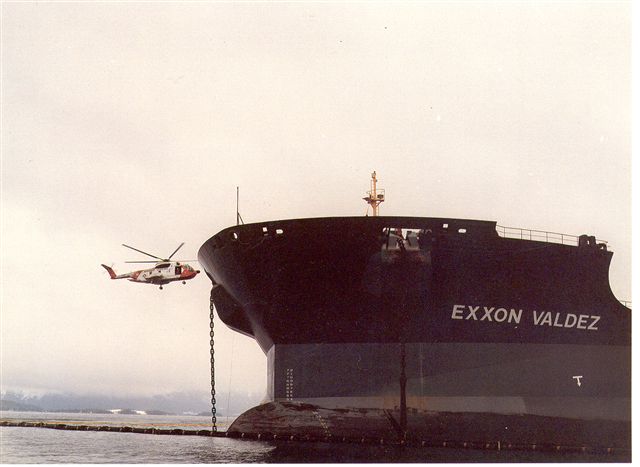 Production of a barrel of Canadian Tar Sand synthetic crude oil consumes about 1,200 cubic feet of natural gas.
Production of a barrel of Canadian Tar Sand synthetic crude oil consumes about 1,200 cubic feet of natural gas.
This means that 4.5 BCFD of Alaskan Natural Gas could process Canadian Tar Sands and yield 3.75 MMBPD of synthetic crude oil.
One of the best examples of the link between Alaskan natural gas and Canadian Tar Sands is ConocoPhillips.
ConocoPhillips can produce about 1/2 of the Alaskan Natural gas or about 2 BCFD.
The ConocoPhillips - Encana joint venture seeks to produce about 0.4 to 0.6 MMBPD of tar sand product depending which story you read. That would consume about 16% of the Alaskan natural gas production.
Heavy oil from Canada can replace heavy oil from Venezuela in ConocoPhillips Lower 48 refineries.
The heavy oil from Canada will reach ConocoPhillips refineries by way of the Keystone Pipeline, a joint venture with TransCanada.
The business case for a ConocoPhillips led Alaska Gas Pipeline is compelling. For ConocoPhillips and their partners the project is a Win-Win-Win-Win.
Win #1 Monetization of stranded Alaskan Natural Gas Resources.
Win #2 Natural Gas feedstock for Tar Sand Oil production provided at cost.
Win #3 Secure heavy oil feedstock for existing refineries.
Win #4 Sell Alaskan natural gas to other Tar Sand Oil Producers at a profit.
I'm presenting my interpretation of ConocoPhillips business case for an Alaskan Natural Gas Pipeline to show the contrast to the TransCanada business case.
TransCanada wants a lot of government support (including a $500,000,000 inducement from Alaska) to build a pipeline and receive a fixed, predictable profits for transporting Alaskan Gas to Alberta. The other 49 U.S. States will be asked to chip in and buy gas to fill the pipeline when the U.S. Government becomes the "Bridge Shipper"
It's a sweet deal for TransCanada if they can pull it off.
Here's the economics lesson for Alaskans - There's a fixed amount of income that will come from producing Alaskan Natural Gas - Whatever cost are paid to Canadians reduces the amount that should go to Alaskans (Americans) as jobs, profits, reinvestment in oil & gas development, and tax revenue.
No matter how much folks enjoy badmouthing the Producers - High profits for TransCanada is not the optimum business case for the producers, Alaskans, or the Lower 48.
Photos from: Dirty Oil , Technology Review By Katherine Bourzac. Pipe Photo from Grand Forks Herald
Sunday, March 30, 2008
The Need for Alaskan Gas & The Case for a ConocoPhillips Natural Gas Pipeline
Posted by
AK Engineer
at
3:23 PM
1 comments
![]()
![]()
Labels: Alaska Gas Pipeline TransCanada ConocoPhillips, Encana Keystone Pipeline
Friday, March 28, 2008
Palin Announces May 19th is Decision Day for TransCanada Pipeline Proposal
Stefan Milkowski reports in the Fairbanks News Miner Blog "Capital Focus" that:
Gov. Sarah Palin announced this morning she will hold a special legislative session in Juneau starting on June 3 to deal with the natural gas pipeline.
Palin also announced that her administration will present its decision on the TransCanada pipeline proposal to lawmakers the week of May 19. If the administration decides to go ahead with the TransCanada plan, the announcement in May will begin the 60-day review period allowed to lawmakers under the Alaska Gasline Inducement Act.
KTUU carried the same story and originally posted a poll. The KTUU poll got pulled so I pulled my link to it. Maybe they didn't like the poll results.Thanks for Voting!
Posted by
AK Engineer
at
5:56 PM
0
comments
![]()
![]()
25% Rate of Return?
 According to the Anchorage Daily News: Steve Porter, the state's deputy revenue commissioner, said the proposed 14 percent return on investment for TransCanada could rise to 25 percent.
According to the Anchorage Daily News: Steve Porter, the state's deputy revenue commissioner, said the proposed 14 percent return on investment for TransCanada could rise to 25 percent.
That's a lot of loonies!
It's may be a good time for ConocoPhillips to step up and explain what sort of rate of return they are looking for. The whole idea of the Alaska Gas Inducement Act (AGIA) was to promote openness transparency.
Speaking of transparency - isn't about time for the administration of Governor Sarah Palin to step up and define the tax structure for the North Slope Producers?
There's still a few pieces missing from this pipeline project puzzle.
Link to the Fairbanks News Miner story on this topic.
Posted by
AK Engineer
at
3:55 AM
0
comments
![]()
![]()
Thursday, March 27, 2008
Point Thomson - In the Balance

From the Alaska Journal of Commerce: "ExxonMobil submitted a plan Feb. 19 to develop a $1.3 billion gas condensate production and gas recycling plant at Point Thomson that would produce 10,000 barrels per day of liquid condensates, which can be blended with crude oil and shipped through the trans-Alaska oil pipeline."
At last count this was plan #23 and ExxonMobil has committed to start work next winter. The economics of developing a high pressure formation are complex and it's good to see that the rate of return is acceptable for a firm capable of producing it.
The question remains - Will the State of Alaska accept the proposal and allow Exxon to go work, or is it back to court house for another round?
Posted by
AK Engineer
at
3:42 AM
0
comments
![]()
![]()
Saturday, March 22, 2008
Agrium Out Of Gas
 On March 13th Agrium pulled the plug on plans to build a $2 billion dollar coal gasification plant.
On March 13th Agrium pulled the plug on plans to build a $2 billion dollar coal gasification plant.
The new plant would have supplied the Kenai ammonia plant with gas and consumed 3 million tons per year of Alaskan coal.
Agrium is still on track to implement a similar technology to convert petroleum coke to gas in energy-business friendly Louisiana. That plant will feature carbon capture technology. The carbon dioxide will be used to help unlock more crude oil from mature oil fields.
Well done Louisiana! 
Cutting edge technology, job growth, converting a low value resource into multiple income streams, environmentally sensitive, and extending the life of an aging oil field.
The list of losers is pretty long for Alaska - Kenai & Healy lose jobs, no carbon capture or enhanced oil recovery for Cook Inlet, fewer exports and less work for the construction industry. This is the model of economic development that comes from the unfriendly business climate established by the new Governor.
Posted by
AK Engineer
at
4:25 AM
2
comments
![]()
![]()
Wednesday, March 19, 2008
Lisa Murkowski - "Nothing stopping us...but possibly ourselves."
 In a speech before the Alaska Legislator Senator Murkowski had a few words about the Alaska Gas Pipeline.
In a speech before the Alaska Legislator Senator Murkowski had a few words about the Alaska Gas Pipeline.
"We are slipping and cannot afford to slip any further. Our competitors are moving ahead. Our oil production is dropping. Steel and construction prices climb higher every year."
"There is nothing stopping us from getting a gas line built, but possibly ourselves."
Read the full text of her speech here.
Posted by
AK Engineer
at
3:55 AM
1 comments
![]()
![]()
Friday, March 14, 2008
FERC and DOE Report on the Future of the Alaska Oil & Gas Production
 On February 19th FERC made this report to Congress Titled "Fifth Report to Congress on Progress Made in Licensing and Constructing the Alaska Natural Gas Pipeline" Here's a link to FERC's Alaska Natural Gas Transportation Projects webpage.
On February 19th FERC made this report to Congress Titled "Fifth Report to Congress on Progress Made in Licensing and Constructing the Alaska Natural Gas Pipeline" Here's a link to FERC's Alaska Natural Gas Transportation Projects webpage. The Department of Energy (DOE) also issued a report titled "Alaska North Slope Oil and Gas A Promising Future or an Area in Decline"
The Department of Energy (DOE) also issued a report titled "Alaska North Slope Oil and Gas A Promising Future or an Area in Decline"
The DOE report assumes a natural gas pipeline will be in operation by 2016.
The FERC report indicates that teh federal agencies are standing by to facilitate and expedite the pipeline regulatory process. FERC's conclusions are not limited to Governor Palin's AGIA process.
The FERC report concludes "Clearly, a proposed project which is backed by firm shipper commitments to transport natural gas supplies will have a greater chance of ultimate success."
This is a clear indication that pipeline builder must have a committed producer as a partner to make the Alaska Gas Pipeline a reality.
Posted by
AK Engineer
at
7:29 PM
0
comments
![]()
![]()
Labels: Alaska Gas Pipeline FERC DOE
TransCanada Pipeline Permit Approved
 Today the TransCanada - ConocoPhillips Keystone oil pipeline received a permit from the State Department that allows construction to begin.
Today the TransCanada - ConocoPhillips Keystone oil pipeline received a permit from the State Department that allows construction to begin.
 Engineering giant Bechtel will start construction of the pipeline in April. The German firm Siemens will supply electrical and pumping equipment for the project.
Engineering giant Bechtel will start construction of the pipeline in April. The German firm Siemens will supply electrical and pumping equipment for the project.
Well done - It's nice to know that governments and industry can work together and launch mega projects like Keystone. Let's hope the same can be said of the Alaska Gas Pipeline soon.
Posted by
AK Engineer
at
6:21 PM
0
comments
![]()
![]()
Labels: Keystone Pipeline ConocoPhillips TransCanada Bechtel, Siemens
Tuesday, March 11, 2008
Remember Gas to Liquids?
 With crude oil trading above the $100 mark and diesel prices over $3.50 I wonder why we don't hear more about gas to liquid projects for North Slope gas.
With crude oil trading above the $100 mark and diesel prices over $3.50 I wonder why we don't hear more about gas to liquid projects for North Slope gas.
Shell is looking forward to completion of an $18 Billion dollar GTL project in Qatar. The reported payback period is four years - not bad.
A North Slope GTL plant could feature carbon dioxide capture technology. The carbon dioxide could be re-injected into oil bearing formations to extend the productive life of the oil reservoirs.
Additional revenue could be obtained by selling carbon credits, making an Alaska GTL plant the must-do project for the global warming crowd.
If the Shell project can produce diesel and condensate for $6/BOE it may be time for Alaska to give GTL another look.
Shell GTL History Video:
Posted by
AK Engineer
at
6:45 PM
0
comments
![]()
![]()
Sunday, March 9, 2008
Alaska Gas Pipeline Gets a Federal Reality Check
 Last week, Guy Caruso, Chief of the Energy Information Agency gave Testimony before the Senate Committee on Energy and Natural Resources.
Last week, Guy Caruso, Chief of the Energy Information Agency gave Testimony before the Senate Committee on Energy and Natural Resources.
Caruso testified that "The Alaska natural gas pipeline is expected to be completed in 2020, later than previously anticipated, because of delays in the resolution of issues between Alaska's State government and industry participants."
Alaska Senator Lisa Murkowski made the statement that "we anticipated that Alaska’s gas would be online in about 2012. A couple years ago the projection was it was going to be here in 2014. Last year when you came to speak to us the assessment was going to be 2016. This year you bumped back to 2018."
This is how Murkowski described the current efforts of Alaska's Governor Sarah Palin "As you know we’re waiting anxiously, from the State’s perspective— the new Governor is rolling out her new legislation of inducements to get participants so we can get this gas line moving forward."
Murkowski doesn't sound very enthusiastic about Palin's process or progress. The EIA estimate seems to imply that the State and producers will reach agreement at some point down the road. Doing the math - that point down the road could be after Palin leaves office.
Murkowski went on to talk about North Slope production cost and rates of return for producers - the kind of then you might expect from an Economics major. Fact and figures that appear to be lost on the Governor with a degree in Journalism.
Posted by
AK Engineer
at
6:46 PM
0
comments
![]()
![]()
Friday, March 7, 2008
Sarah Palin - Media Favorite
Media darling, Alaska's Governor Sarah Palin continues to get credit for playing hardball with North Slope producers. This week we learned that the Department of Energy is dreaming up alternatives to the pipeline if the AGIA process does not yield a pipeline.
Swell. A Governor who will not address the central issue of fiscal certainty - the one issue that would pave the way for investment in the Alaska Gas Pipeline, and federal bureaucrats who think they can build a better pipeline.
Meanwhile the preselected pipeline constructor, TransCanada is hoping that the federal government will step in and act as a bridge shipper of gas. Uncle Ted Stevens thinks that idea won't work but what does he know - he's only been in the Senate for about 40 years.
Real Progress this week:
ConocoPhillips and TransCanada obtained a Federal permit and go ahead for construction of the Keystone pipeline.
ExxonMobil announced plans for $125 Billion in capital spending over the next 5 years (That's over three times the current estimate for the Alaska Gas Pipeline.
Some of that ExxonMobil investment will be made in Alaska at Point Thomson if the Alaska Department of Natural Resources agree with a plan presented by Exxon this week.
Posted by
AK Engineer
at
5:27 PM
1 comments
![]()
![]()
Labels: Alaska Gas Pipeline ExxonMobil ConocoPhillips TransCanada Ted Stevens Sarah Palin
Wednesday, March 5, 2008
Prudhoe Bay - Highest Production Tax in the World
 So says BP Exploration (Alaska) Inc President Doug Suttles in a presentation to Anchorage Chamber of Commerce.
So says BP Exploration (Alaska) Inc President Doug Suttles in a presentation to Anchorage Chamber of Commerce.
Suttles went on to give low marks to Alaska Governor Sarah Palin's Alaska Gas Pipeline plans, saying "You would have thought that the world's big companies, whether they were pipeline companies or whether they were gas companies, would want to be part of it. But only one showed up. I think that tells you about the framework that we have in place today and the problems with that framework."
Maybe Suttles is thinking "Beyond Palin"
Posted by
AK Engineer
at
4:02 AM
2
comments
![]()
![]()
Labels: Doug Suttles Sarah Palin BP Prudhoe Bay Alaska Gas Pipeline
Monday, March 3, 2008
Bloomberg Compares Palin with Hugo Chavez
 According to this Bloomberg article by Joe Carroll and Sonja Franklin, Sarah Palin is "Succeeding where Venezuela President Hugo Chavez has failed"
According to this Bloomberg article by Joe Carroll and Sonja Franklin, Sarah Palin is "Succeeding where Venezuela President Hugo Chavez has failed"
Before this article came out I avoided comparing Palin and Chavez. The two leaders are both popular and use the multinational oil and gas firms as punching bags to whip up support among their followers.
Bloomberg correctly points out the Palin takes a tough stance with the North Slope producers, but the article is short on proof of success.
Bloomberg points out that Palin has increased taxes on oil and gas firms but does not mention the subsequent multi billion dollar reduction in capital expenditure.
The loss of investment in Alaska's oil patch equals lost jobs today and lost revenue in the future. That business model is alive and well in Chavez's Venezuela.
Palin was not elected for her own achievements but by running as the Anti-Big Oil, Anti Frank Murkowski candidate. She lacks the support of other Republicans from Alaska.
Without an Alaska Gas Pipeline she will leave office as a one-hit wonder and the comparisons to Hugo Chavez will be all too accurate.
Let's hope that Palin does succeed. Palin's current approach can go terribly wrong, impacting Alaskans and the lower 48 for decades to come.
Posted by
AK Engineer
at
7:05 PM
1 comments
![]()
![]()
Labels: Alaska Gas Pipeline Exxon XOM Sarah Palin, Hugo Chavez
Sunday, March 2, 2008
Quiet Week for the Alaska Gas Pipeline

Here's a few stories and links of interest:
Alaska’s Economy Might Boom if Palin Goes to Washington by PAUL JENKINS - Paul Outlines the upside for the Alaska Gas Pipeline if Gov. Palin runs for Vice President.
Consultant Urges Tax Stability for Natural Gas line Companies By Stefan Milkowski. The discussion always comes back to fair taxes and tax stability. Without that the pipeline will not get built.
Alaska Fiscal Woes Give Oil Firms The Upper Hand By Robert Campbell - Analysis. A reality check for the Alaska State Budget without a Gas Pipeline.
ConocoPhillips' Exec Says it Will Move Forward with Gas Line By Chris Freiberg - ConocoPhillips is still moving forward. Good for them!
Posted by
AK Engineer
at
5:06 AM
0
comments
![]()
![]()
Saturday, March 1, 2008
Supreme Court Hears the Exxon Valdez Case
 This week the Supreme Court heard the historic case of Exxon v. Baker. At issue should Exxon pay punitive damages and if so how much. I'm interested in this case in terms of how it will shape public opinion during the Alaska Gas Pipeline debate. I found a few items of interest while reading the hearing transcript. First the justices didn't seem to buy the argument that Exxon is not liable for punitive damages.
This week the Supreme Court heard the historic case of Exxon v. Baker. At issue should Exxon pay punitive damages and if so how much. I'm interested in this case in terms of how it will shape public opinion during the Alaska Gas Pipeline debate. I found a few items of interest while reading the hearing transcript. First the justices didn't seem to buy the argument that Exxon is not liable for punitive damages.
Secondly Exxon during an exchange with Justice Ginsburg, Exxon attorney Dellinger hinted at a new trail to answer the question "Was Exxon, itself, reckless in allowing this captain to stay on the ship?" (page 18).
Finally the Court spent some time looking at the amount of the award. On page 31 of the transcript Dellinger floats the idea the maximum punitive damages should not exceed twice actual damages. The Justices focused on this issue and grilled the Plaintiff's attorney Mr. Fisher.
Predictions: In late May or June the Court will find that Exxon must pay punitive damages, but the amount will be lowered to somewhere in the $1 Billion range.
The reduced damages will fuel the anti oil company fever that seems to cloud the gas pipeline debate.
Here's a good review in the Cordova Times.
Posted by
AK Engineer
at
4:20 AM
0
comments
![]()
![]()




